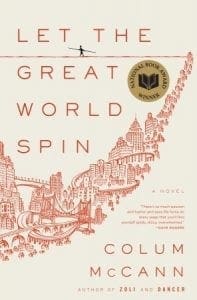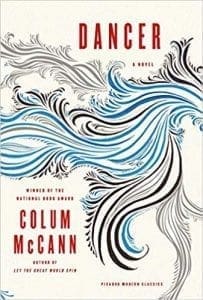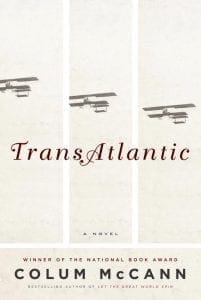We all love a good novel. There’s nothing quite like getting lost in a book, feeling as if you’re living a story rather than merely reading about it. But the hardest part is often making a choice. How do you decide between the millions of books out there? Sometimes we get lucky in our search process, and we find an author that speaks to us in ways others do not. Finding an author we can trust, who excites and inspires us, is the reader’s dream. And, of course, we proceed to read their entire body of work. I’ve had the pleasure of discovering such an author, a writer of Irish-decent named Colum McCann. I hope to share with you just a sliver of what makes him so great and why his books should be next on your reading list.
Who is Colum McCann?
Colum McCann was born and raised in Dublin, Ireland, and is best known for his work in the literary fiction genre. He has published seven novels and three collections of stories. McCann also has won awards for his writing across the globe, so much so that we’d have to dedicate an entire section to them in this piece were we to name them all. He’s even written for numerous publications, including The New York Times, the Irish Times, and The Guardian, to name a few. Currently, he is a professor in the Creative Writing Program at Hunter College in New York City, one of the country’s most prestigious programs, accepting only six students a year.
He is also still writing, as his most recent novel, “Apeirogon,” was published in February of this year. But enough on his bio, let’s talk about what makes him such an influential author.
McCann’s Specialties
No Boundaries
Colum McCann is the kind of person who always sees a story, no matter what he’s looking at or whatever the situation is. When it comes to topics or themes for stories, McCann has no boundaries. He can make a compelling novel out of any circumstances, period, place, what have you. This is wholly evident in his books’ subject matters. Just in the books featured below, the themes include surviving NYC in the ’70s, the enduring factors of changing history, and the life of a world-famous male dancer. McCann loves using historical moments and facts as the initial building blocks for his stories; from there, it’s all imagination and brilliance. Even within the books themselves, the range of characters and stories is limitless.

It’s not only with characters and topics that McCann lacks boundaries; the same can be said for time frames in books. McCann will quite often jump from one time period to the next; one second, you’re in the 1800s in Europe, the next, you’re stateside at the tail end of the 20th century. But as you’ll see in the next section, all of this jumping around is entirely intentional. His ability to stretch stories out for long periods shows a kind of domino effect, in the sense that you continue to see the impact, influence, and development of a character over time. Colum McCann’s breadth of knowledge and fearlessness in breaking down boundaries is part of what makes his work so compelling. He beautifully reminds us that stories are easy to find in life if you’re willing to listen and empathize.
Puzzle Piece Format
I started to touch on his preferred format in the last section, as reading his books is truly like solving some kind of literary puzzle. The way McCann structures his work demonstrates his mastery of storytelling. You can throw out the typical framework of a story here; his books aren’t about reaching some climactic moment like you’re used to. If anything, the climax is when everything finally comes together for the reader. You have this moment where all of the different stories within his books become fully connected to complete the journey. He can control the reader’s path while not allowing himself to determine opinion, for that he leaves to the reader.
The web of stories McCann utilizes in each book is part of what makes his work so intriguing as a reader. Once you start, you can’t stop; you have to see it through. It’s a beautiful technique to get around the need for constant moments of conflict; every page and word has purpose in McCann’s books. He can make the world feel so small and remind us of how true that notion is in life. Everyone and everything has a different story, yet McCann finds commonalities amongst what we’d perceive to be the starkest of differences.
Character Development & A Knack for Capturing Humanity
Perhaps McCann’s most extraordinary talent is his ability to empathize. It’s easy for us to forget in the daily workings of life that we’re all humans with different stories, backgrounds, and experiences at the end of the day. In each level, within each book, McCann shows how us humans are like icebergs, if you will, with what we offer on the surface being just a small slice of what makes up our story in life. After reading one of his books, you might find yourself a bit more hesitant to pass judgment and a little more open to those around you. McCann’s empathy and awareness make it easy for him to create understanding in the most stubborn of readers; not a single bone of arrogance exists in McCann’s body, and you feel that as you read.
Such qualities are what make the connection you feel toward each character so powerful and genuine. McCann’s empathy is contagious. When you read his work, you’re hit with a refreshing feeling of judging not always by perceived right and wrong but by one human attempting to understand another human. McCann paints complete pictures of people, and you’ll find that it may change your initial impressions. He’s not afraid to take you into a character’s darkest moments to bring you to their brightest.
McCann is genuinely brilliant at showing humanity’s true colors, which are not as black and white as we paint them to be. He shows us that we all bear stories in life, full of high and low moments. But that at the end of the day, he reminds us that we all share one often forgotten similarity in that we’re all humans trying to figure this life thing out. Right now, of all times, we could all benefit from reading McCann’s work.
Colum McCann’s Best Work
It should be noted that the books that follow are just a few selections that I thought painted the most comprehensive picture of his body of work. I’ve read nearly everything else he’s put out, and not a single book has yet to disappoint. Check his full body of work here.
Let the Great World Spin

Starting with the obvious, his most famous piece of work, “Let the Great World Spin.” This book is a true world-renowned masterpiece. It was the 2009 National Book Award Winner, a bestseller in four continents, and unsurprisingly a New York Times bestseller. The accolades for this book seemingly never end, and deservedly so. The New York Times labeled it “an emotional tour de force,” which I thought brilliantly captured this book. “Let the Great World Spin” is built entirely around one central, real-life moment, in which a man walked on a tightrope across the Twin Towers in 1974. This one fascinating moment in history is the glue that holds the book and all of its characters together. This book features all the feels, from love to pain, to happiness, to mystery, all within NYC’s turbulent times in the ’70s.
The story features several vastly different characters, such as an Irish monk, a prostitute, and a young female artist, to name a few. All of whom you’d expect to be as opposite as can be, but as McCann beautifully shows, they all share the enduring similarity of being human beings managing life in New York City at its most fragile point. “Let the Great World Spin” is the perfect book for anyone who has lived or lives in NYC or any major city for that matter; it’ll ultimately make you rethink your perspective on the people you encounter daily. I talked extensively before about McCann’s remarkable ability to empathize, and nowhere else is it more on display than in “Let the Great World Spin.”
Dancer

Another fantastic mix of real-life and fiction, so much so that it’s incredibly hard to know where the line is drawn here. “Dancer” tells the story of Russian dancer Rudolf Nureyev, a world-famous dancer, and celebrity of sorts. The book covers four decades, starting from around the Second World War and going up to the ‘80s. McCann’s website calls the book “erotically charged,” which I’d say is putting it lightly. Nureyev had a curious sexuality in a time when such a thing had anything but acceptance. His celebrity saves him from the same degree of hardship a similar but non-famous person might experience back then, but it’s a rocky path nonetheless.
McCann was primarily influenced by biographical facts on the life of Nureyev. Still, he does us the favor of filling in the blank space, creating a captivating story in the process. Like I said before, it’s hard to know what’s fact and fiction in this book as McCann weaves in several real-life characters who had association with Nureyev like Andy Warhol and John Lennon. I usually strive for truth over narrative, but after reading this book, I was too concerned my search for the truth might compromise a fascinating story. To sum it up, “Dancer” is the story of a world-famous dancer told mostly from the perspectives of those in his life, however brief or inconsequential those relationships may be. This story’s backbone is Nureyev’s never-ending quest for perfection and the riches and personal destruction that came with it.
TransAtlantic

We again see the commonalities of McCann’s approach in this book. In this piece of work, he weaves in even more history and takes us on a time-traveling journey. “TransAtlantic” spans numerous continents and multiple centuries. With that, comes a whole slew of captivating characters, including none other than Fredrick Douglas. McCann’s ability to seamlessly transition between starkly different periods, places, and characters is spectacular in this book. You’ll go from Newfoundland in 1919 to Dublin in 1845 and then over to NYC in the late 1990s. Even with all of this jumping around, there’s still a simplistic flow to this book. You’ll always feel like you’re moving in the same direction, despite how vastly different the current setting might be from the last.
At the heart of this book are two core themes. The first is how history progresses and evolves over time, specifically with the challenges of rewriting history. The other theme is the persistence of human nature, and how no matter the time, the difficulty of pursuing change in a harsh world weighs upon a person. Which you can bet is a purposeful demonstration by McCann. Like I said earlier, the book always feels connected despite how different each context and character might be.
McCann doesn’t use historical facts to piece together a story that capitalizes on drama or stretching the truth. His work feels like a genuine telling of what happened, even though you know a good deal is fiction. It’s as if McCann is an ever-traveling, immortal fly on the wall. He allows us to peek into Dublin in the 1800s just as transparently as he illustrates NYC in the 1990s. Yet again, McCann’s storytelling genius is on display in “TransAtlantic.”
P.S.
For any writers out there, I’d also suggest reading McCann’s book “Letters to a Young Writer.” In this short book, you’ll get a sense not just of how he’s made a successful career as an author, but as a professor as well. If you’re missing that last gear of motivation and self-belief, then allow McCann to give you that nudge forward.
Main photography credit: @ Richard Gilligan 2009
Garrett is a writer at The Digest. He currently lives in Astoria, NY, and loves writing about topics that make readers think. His passions include film, sports, traveling, and culture.
- Garrett Rutledgehttps://thedigestonline.com/author/grutledge/
- Garrett Rutledgehttps://thedigestonline.com/author/grutledge/
- Garrett Rutledgehttps://thedigestonline.com/author/grutledge/
- Garrett Rutledgehttps://thedigestonline.com/author/grutledge/


